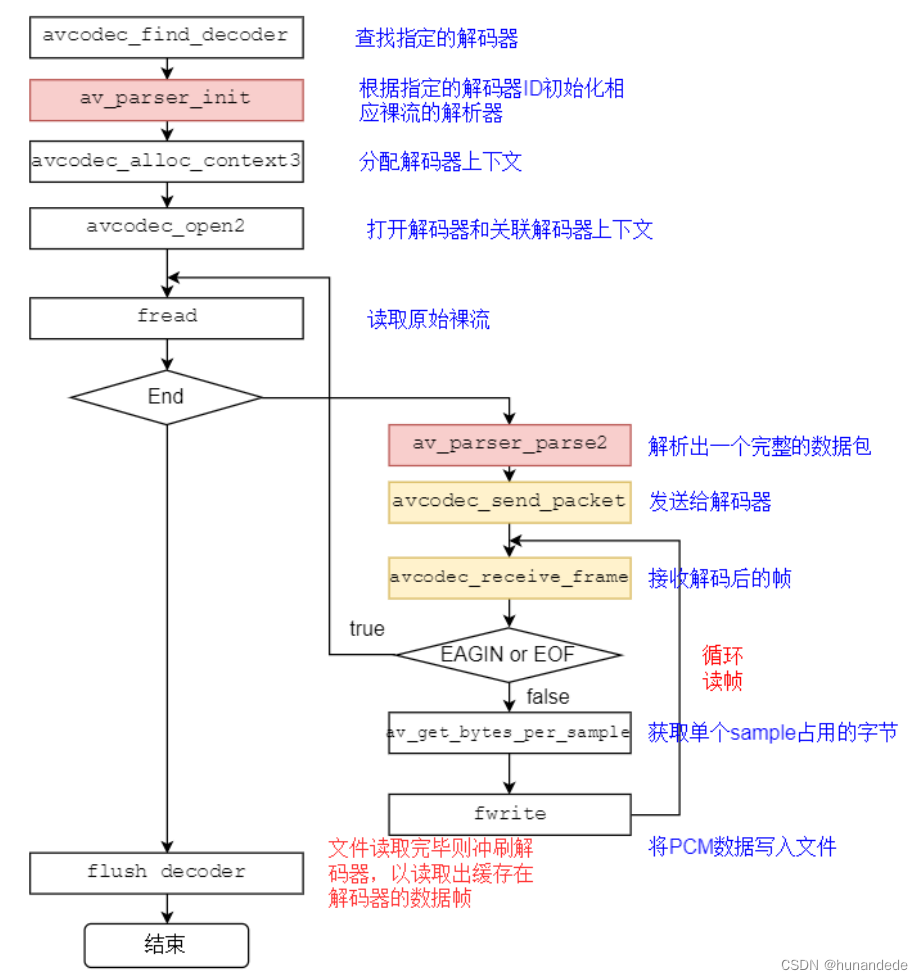这一节,接 音视频开发12 FFmpeg 解复用详情分析,前面我们已经对一个 MP4文件,或者 FLV文件,或者TS文件进行了 解复用,解出来的 视频是H264,音频是AAC,那么接下来就要对H264和AAC进行处理,这一节 主要是对 AAC进行处理。
⾳频解码过程

FFmpeg流程解码过程

关键函数说明
1.找到想要的编解码器
const AVCodec *avcodec_find_decoder(enum AVCodecID id);
根据AVCodecID 查找对应的AVCodec
根据AVCodecID 查找对应的AVCodec
/**
* Find a registered decoder with a matching codec ID.
*
* @param id AVCodecID of the requested decoder
* @return A decoder if one was found, NULL otherwise.
*/
const AVCodec *avcodec_find_decoder(enum AVCodecID id);
这个 AVCodecID 代表的是 解码器 或者 编码器 的 ID
enum AVCodecID {
AV_CODEC_ID_NONE,
......
//video codecs
AV_CODEC_ID_H264,
......
//audio codecs
AV_CODEC_ID_MP3,
AV_CODEC_ID_AAC,
......
//pcm codecs
AV_CODEC_ID_PCM_U16LE
//subtitle codecs
AV_CODEC_ID_DVD_SUBTITLE
}但是这里有一个问题,就是我们一般在解析一个文件的时候,并不知道这个文件的音频和视频用的什么编码,也就不知道用什么解码器解码比较好,合理的写法有两种,如下:
第一种,在前面解封装的时候,通过 avformat_find_stream_info 方法我们得到过文件的详细信息:然后通过 avformatcontext 得到 每一个AVStream,通过AVStream就可以得到codecid,然后就可以得到AVCodec。
但是这里无法分清楚那个是音频,哪个是视频,还需要进一步的判断:
for (i = 0; i < ifmt_ctx->nb_streams; i++) {
AVStream *stream = avformatcontext->streams[i];
const AVCodec *dec = avcodec_find_decoder(stream->codecpar->codec_id);
。。。。。。
}另一种方式:使用 av_find_best_stream 函数 获得指定的 avformatcontext中的最佳的stream。这时候通过传递进去一个 AVCodec,方法完成后就能得到对应的AVCodec
注意你要得到的 解码器 avcodec,是通过指针的形式传递进去的。
int av_find_best_stream(AVFormatContext *avformatcontext,
enum AVMediaType type,
int wanted_stream_nb,
int related_stream,
const struct AVCodec **decoder_ret,
int flags);
参数说明
ic:AVFormatContext指针,表示输入的媒体文件上下文。
type:要查找的媒体流类型,可以是音频流、视频流或字幕流等。
wanted_stream_nb:期望的媒体流索引号,可以是特定的索引号,也可以是AV_NOPTS_VALUE(-1)表示任意流。
related_stream:前一个相关流的索引号,如果没有前一个相关流,则传入-1。
decoder_ret:返回解码器指针。
flags:查找最佳流的标志位,默认为0。
返回值:
找到的最佳匹配媒体流的索引号,如果找不到则返回AVERROR_STREAM_NOT_FOUND。
* @return the non-negative stream number in case of success,
* AVERROR_STREAM_NOT_FOUND if no stream with the requested type
* could be found,
* AVERROR_DECODER_NOT_FOUND if streams were found but no decoder
*
* @note If av_find_best_stream returns successfully and decoder_ret is not
* NULL, then *decoder_ret is guaranteed to be set to a valid AVCodec.
•avcodec_find_decoder_by_name():根据解码器名字 找到解码器,这里有一个问题,这个name从哪里得到呢?
在windows cmd 下,输入 ffmpeg -h,就可以看到
Print help / information / capabilities:
-L show license
-h <topic> show help
-version show version
-muxers show available muxers
-demuxers show available demuxers
-devices show available devices
-decoders show available decoders
-encoders show available encoders
-filters show available filters
-pix_fmts show available pixel formats
-layouts show standard channel layouts
-sample_fmts show available audio sample formats我们是要找解码器的,因此 ffmpeg -decoders 就可以将所有的解码器列出来,为了方便查找,还可以将存储到 一个txt 中
ffmpeg -decoders > a.txt
在a.txt中看当前ffmpeg 支持的 decoder 的name有哪些,对应的如下的012v,4xm就是video的解码器名字,也可以当前查找关键字,例如aac,h264 就更快一些。
Decoders:
V..... = Video
A..... = Audio
S..... = Subtitle
.F.... = Frame-level multithreading
..S... = Slice-level multithreading
...X.. = Codec is experimental
....B. = Supports draw_horiz_band
.....D = Supports direct rendering method 1
------
V....D 012v Uncompressed 4:2:2 10-bit
V....D 4xm 4X Movie
V....D 8bps QuickTime 8BPS video
...................
A....D aac AAC (Advanced Audio Coding)
A....D aac_fixed AAC (Advanced Audio Coding) (codec aac)
A....D libfdk_aac Fraunhofer FDK AAC (codec aac)
A....D aac_latm AAC LATM (Advanced Audio Coding LATM syntax)
.................
V....D h261 H.261
V...BD h263 H.263 / H.263-1996, H.263+ / H.263-1998 / H.263 version 2
V...BD h263i Intel H.263
V...BD h263p H.263 / H.263-1996, H.263+ / H.263-1998 / H.263 version 2
VFS..D h264 H.264 / AVC / MPEG-4 AVC / MPEG-4 part 10
VFS..D hap Vidvox Hap
VF...D hdr HDR (Radiance RGBE format) image/**
* Find a registered decoder with the specified name.
*
* @param name name of the requested decoder
* @return A decoder if one was found, NULL otherwise.
*/
const AVCodec *avcodec_find_decoder_by_name(const char *name);到这里,我们就有了解码器了(AVCodec),有了解码器还不行,还需要有解码器上下文,这里谈一下为什么有了解码器 还需要有 解码器上下文。
假设有一个视频文件,里面有3路视频,3路音频,有两路视频都是H264的,如果数据都保存到解码器里面,多路解码的时候,数据会有冲突,因此要多设计一个AVCodecContext.
也就是说,在ffmpeg 中,AVCodec 中一般存储的是方法,AVCodecContext 中则存储了该AVCodec中的具体数据。实际上 ffmpeg 中一直就延续这种风格,xxxcontext中存储的都是对应的xxx的数据,而 xxx中则是对应的方法之类的。
我们具体的来看:struct AVCodec
我们观察AVCodec, 看到AVCodec 中的内容,都是
该 AVCodec支持的supported_framerates 数组。
该 AVCodec支持的 enum AVPixelFormat *pix_fmt 数组。
该 AVCodec支持的 supported_samplerates 数组。
该 AVCodec支持的 AVSampleFormat 数组。
typedef struct AVCodec {
/**
* Name of the codec implementation.
* The name is globally unique among encoders and among decoders (but an
* encoder and a decoder can share the same name).
* This is the primary way to find a codec from the user perspective.
*/
const char *name;
/**
* Descriptive name for the codec, meant to be more human readable than name.
* You should use the NULL_IF_CONFIG_SMALL() macro to define it.
*/
const char *long_name;
enum AVMediaType type;
enum AVCodecID id;
/**
* Codec capabilities.
* see AV_CODEC_CAP_*
*/
int capabilities;
uint8_t max_lowres; ///< maximum value for lowres supported by the decoder
const AVRational *supported_framerates; ///< array of supported framerates, or NULL if any, array is terminated by {0,0}
const enum AVPixelFormat *pix_fmts; ///< array of supported pixel formats, or NULL if unknown, array is terminated by -1
const int *supported_samplerates; ///< array of supported audio samplerates, or NULL if unknown, array is terminated by 0
const enum AVSampleFormat *sample_fmts; ///< array of supported sample formats, or NULL if unknown, array is terminated by -1
const AVClass *priv_class; ///< AVClass for the private context
const AVProfile *profiles; ///< array of recognized profiles, or NULL if unknown, array is terminated by {AV_PROFILE_UNKNOWN}
/**
* Group name of the codec implementation.
* This is a short symbolic name of the wrapper backing this codec. A
* wrapper uses some kind of external implementation for the codec, such
* as an external library, or a codec implementation provided by the OS or
* the hardware.
* If this field is NULL, this is a builtin, libavcodec native codec.
* If non-NULL, this will be the suffix in AVCodec.name in most cases
* (usually AVCodec.name will be of the form "<codec_name>_<wrapper_name>").
*/
const char *wrapper_name;
/**
* Array of supported channel layouts, terminated with a zeroed layout.
*/
const AVChannelLayout *ch_layouts;
} AVCodec;再来看一下 AVCodecContext 的内容。里面存储了当前的avcodec的具体的数据,我们的这个
AVCodecContext 内容太多了。 这里如果要看,直接看源码比较好
2. 给解码器 分配 解码器上下文,并初始化一些default value,注意这时候 解码器上下文还是没有值
我们在这里debug 一下,看这时候 AVCodecContext 里面的内容是啥?
AVCodecContext *avcodec_alloc_context3(const AVCodec *codec);
/**
* Allocate an AVCodecContext and set its fields to default values. The
* resulting struct should be freed with avcodec_free_context().
*
* @param codec if non-NULL, allocate private data and







 最低0.47元/天 解锁文章
最低0.47元/天 解锁文章
















 1341
1341

 被折叠的 条评论
为什么被折叠?
被折叠的 条评论
为什么被折叠?








